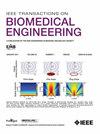用于癫痫发作检测的深度聚类技术
IF 4.4
2区 医学
Q2 ENGINEERING, BIOMEDICAL
引用次数: 0
摘要
癫痫是一种以复发性癫痫发作为特征的神经系统疾病,其往往不可预测,并增加死亡率和发病率风险。目的:本研究的目的是通过引入一种新的方法,深度嵌入高斯混合(DEGM)来解决基于脑电图的癫痫发作检测的挑战。方法:DEGM方法首先使用深度自编码器(deep autoencoder, DAE)对输入的脑电数据进行嵌入,然后使用奇异值分解(Singular Value Decomposition, SVD)在实现降维的同时提高嵌入的表征质量。然后采用高斯混合模型(GMM)进行聚类。与传统的监督机器学习和深度学习技术不同,DEGM利用深度聚类(DC)算法进行更有效的癫痫检测。结果:来自两个真实世界癫痫数据集的实证结果证明了DEGM的显著性能。考虑到数据集的庞大规模,该方法的有效性尤其显着,显示了其有效处理大规模脑电数据的能力。结论:总之,DEGM方法为基于脑电图的癫痫发作检测提供了一种新颖有效的方法,解决了数据变异性和伪影污染等关键挑战。意义:DEGM将深度自编码器、SVD和GMM相结合,取得了优于现有方法的聚类性能,在癫痫的生物医学研究和临床应用方面取得了重大进展。它在大型数据集上的强大性能强调了其提高癫痫检测准确性的潜力,最终有助于改善患者的预后。本文章由计算机程序翻译,如有差异,请以英文原文为准。
Deep Clustering for Epileptic Seizure Detection
Epilepsy is a neurological disorder characterized by recurrent epileptic seizures, which are often unpredictable and increase mortality and morbidity risks. Objective: The objective of this study is to address the challenges of EEG-based epileptic seizure detection by introducing a novel methodology, Deep Embedded Gaussian Mixture (DEGM). Methods: The DEGM method begins with a deep autoencoder (DAE) for embedding the input EEG data, followed by Singular Value Decomposition (SVD) to enhance the representational quality of the embedding while achieving dimensionality reduction. A Gaussian Mixture Model (GMM) is then employed for clustering purposes. Unlike conventional supervised machine learning and deep learning techniques, DEGM leverages deep clustering (DC) algorithms for more effective seizure detection. Results: Empirical results from two real-world epileptic datasets demonstrate the notable performance of DEGM. The method's effectiveness is particularly remarkable given the substantial size of the datasets, showcasing its ability to handle large-scale EEG data efficiently. Conclusion: In conclusion, the DEGM methodology provides a novel and effective approach for EEG-based epileptic seizure detection, addressing key challenges such as data variability and artifact contamination. Significance: By combining deep autoencoders, SVD, and GMM, DEGM achieves superior clustering performance compared to existing methods, representing a significant advancement in biomedical research and clinical applications for epilepsy. Its robust performance on large datasets underscores its potential for improving seizure detection accuracy, ultimately contributing to better patient outcomes.
求助全文
通过发布文献求助,成功后即可免费获取论文全文。
去求助
来源期刊

IEEE Transactions on Biomedical Engineering
工程技术-工程:生物医学
CiteScore
9.40
自引率
4.30%
发文量
880
审稿时长
2.5 months
期刊介绍:
IEEE Transactions on Biomedical Engineering contains basic and applied papers dealing with biomedical engineering. Papers range from engineering development in methods and techniques with biomedical applications to experimental and clinical investigations with engineering contributions.
 求助内容:
求助内容: 应助结果提醒方式:
应助结果提醒方式:


